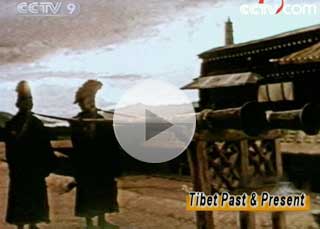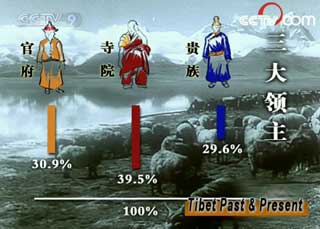------Program code: DO-080503-00392 (what's this?)
Source: CCTV.com
05-03-2008 09:20
Tibet Serfdom
The Tibet region was a typical slave society between the seventh and ninth century. Over the following centuries, slaves turned into serfs, land became occupied territory and villages became manors of serf-owners. Feudal serfdom replaced slavery around the mid-13th century. Tibet's feudal serfdom solidified and self-improved during the Ming and Qing dynasties.
 |
| Watch Video: Part 1 |
In old Tibet,the local government, nobles and high-ranking monks in monasteries were called the three feudal lords. They possessed an absolute majority of production means in the region. They owned over 90-percent of the land, pastures and serfs. There were no land-hold farmers, freemen, or handicraftsmen who broke away from serfdom. Business occupied a very little portion in the social economy. Bartering was still a main form of trade in farming and stock breeding areas. The handicraft industry operated in the form of family workshops and production procedures were not divided by professions. As there were no workshop handicraft, no industry existed.
"Xika" in Tibetan means a manor in farming area, it also refers to a pastoral tribe. Xika was a basic economic organization representing the ownership, distribution and operation of land in the feudal serfdom period of Tibet. Xika was occupied by the three feudal lords. That is, Tibet's land, pastures, even mountains, forests and rivers all belonged to the local feudal government, monasteries and nobles.
 |
The old Tibet was administered under theocracy - a joint dictatorship by monks and nobles. Its executive organ was named Gaxag. All the official positions were filled by upper-ranking monks and nobles. Gaxag's properties might have seemed to be public property but, in reality, only the minority of people with real power like the Dalai Lama had control over the properties.
In the old Tibet under theocracy, the monasteries had the absolute status and power. This came from theocracy and general belief. At the same time, it was supported by the massive amount of money and property owned by the monasteries.
Nobles were another group of feudal lords. They were officials who had rendered outstanding service in the government, as well as family members of upper-ranking monks during the alternation of power. They usually received their properties as bonuses or rewards from the feudal local government.
